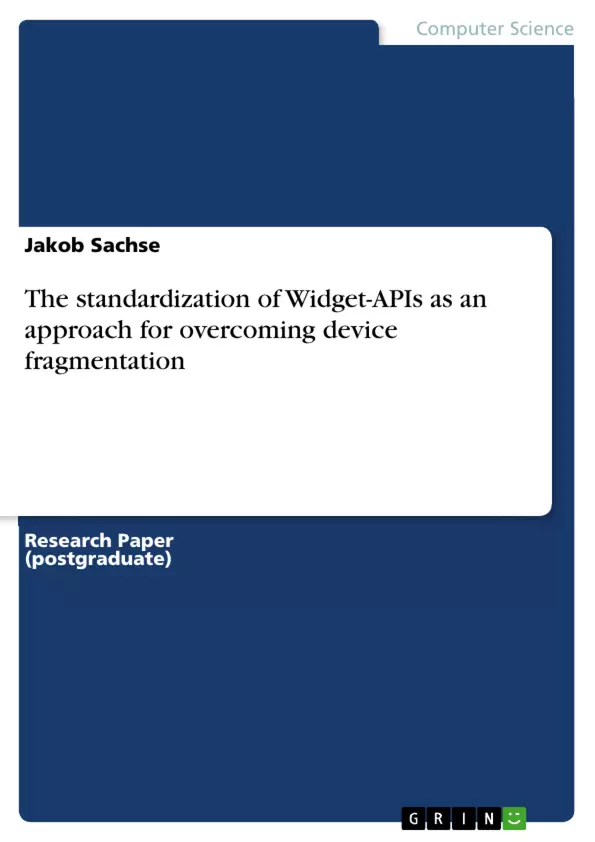Since Apple released the iPhone in 2007 the conversion into a mobile web has accelerated strongly. This paper discusses the challenges resulting from that shift.
The diversity of platforms and device specifications put a heavy burden on developers. While each platform offers an own proprietary API for developing applications it is often desirable to develop applications platform independently. One possible way today is to use web technologies. Although this offers a platform independent API many commonly used system APIs are not accessible. For most applications this is not acceptable since the use of sensors and file I/O is a premise to build modern user experiences.
But now another interesting part of mobile development begins to merge into the sphere of web technology. This is the use of widgets. Widgets were originally designed for desktop use as small single purpose applications but were quickly adapted on the web. Those applications are written using web standards like HTML, CSS and JavaScript.
The widgets we see on the web today can only use the limited JavaScript APIs that is provided by the browsers. Also the W3Cs current widget specification fails to deliver on device APIs, where only packaging and a widgets configuration is specified. That is why new specifications are about to be made and standardized. They describe Widget Engines and their APIs that wrap around modern handsets system APIs.
During the last two years mayor telecommunication companies founded joint ventures like JIL and BONDI to fulfill this goal. Both JIL and BODI have worked out specifications on device APIs and security as well as reference implementations for at least one mobile platform. These results are the input for a new round of widget specification within the W3C.
While there are neither standards nor implementations around today
developers have to handle platform diversity themselves. This problem is tackled by some frameworks of which Phonegap and J2ME-Polish are introduced in the conclusion of this paper.
Inhaltsverzeichnis (Table of Contents)
- Abstract
- Introduction
- Widgets
- Device APIs
- Security
- Packaging
- Configuration
- Widget Engine
- Shortcomings of mobile web
- technical reasons
- marketing reasons
- Current Innovations
- W3C Recommendation
- Joint Innovation Labs (JIL)
- OMTP BONDI
- Wholesale Applications Community
- W3C ongoing work
- Conclusion
- Consequences and Alternatives
- J2MEPolish
- PhoneGap
- Phonegap API Tests
- Use Case I: Virtual Microscope
- User Interface
- Logic
- Use Case II: Shop Finder
- Reading geolocation
- Phonegap Deployment
- References
Zielsetzung und Themenschwerpunkte (Objectives and Key Themes)
This paper explores the challenges presented by the rapid shift towards mobile web usage. It examines the increasing diversity of platforms and device specifications, which pose significant hurdles for developers seeking to create platform-independent applications. While web technologies offer a platform-independent API, they often lack access to essential system APIs. The paper delves into the emerging field of widgets and their potential to bridge this gap by leveraging web standards and providing access to device APIs.
- Device Fragmentation in Mobile Web Development
- The Role of Widgets in Overcoming Platform Diversity
- Standardization Efforts for Widget APIs
- Exploring Alternative Frameworks for Handling Platform Diversity
- Assessing the Capabilities of Phonegap for Cross-Platform Widget Development
Zusammenfassung der Kapitel (Chapter Summaries)
The "Abstract" introduces the challenges of developing for diverse mobile platforms and highlights the potential of widgets for creating platform-independent applications. The "Introduction" traces the evolution of mobile web technologies and discusses the emergence of widgets as a key component of mobile development.
The section "Current Innovations" explores various standardization initiatives aiming to define Widget APIs. These efforts encompass the W3C's recommendations, the Joint Innovation Labs (JIL), the OMTP BONDI project, the Wholesale Applications Community, and ongoing W3C work.
The chapter "Conclusion" summarizes the consequences of device fragmentation and introduces alternative frameworks, such as J2ME-Polish and Phonegap, which offer solutions for handling platform diversity.
The "Phonegap API Tests" section showcases the capabilities of Phonegap through two use cases: a Virtual Microscope and a Shop Finder application. These examples demonstrate how Phonegap facilitates the development of cross-platform widgets.
Schlüsselwörter (Keywords)
The main keywords and focus topics of the text are: mobile web, device fragmentation, widget APIs, standardization, W3C, JIL, BONDI, Phonegap, cross-platform development, mobile application development, user experience, web standards.
- Citar trabajo
- Jakob Sachse (Autor), 2010, The standardization of Widget-APIs as an approach for overcoming device fragmentation, Múnich, GRIN Verlag, https://www.grin.com/document/149097



